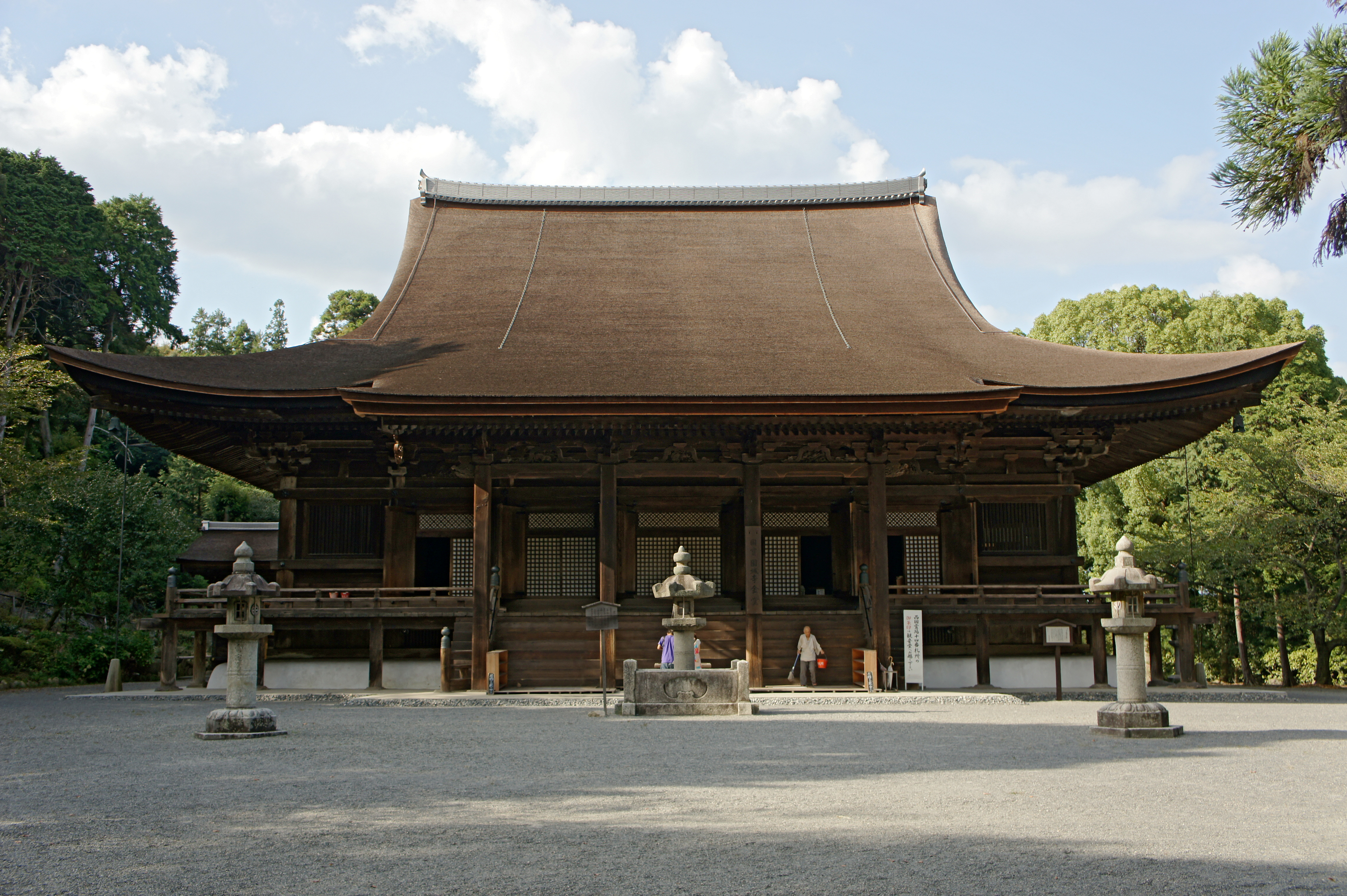|
Mii-dera
, also known as just Onjo-ji, or , is a Buddhist temple in Japan located at the foot of Mount Hiei, in the city of Ōtsu in Shiga Prefecture. It is a short distance from both Kyoto, and Lake Biwa, Japan's largest lake. The head temple of the Jimon sect of Tendai, it is a sister temple to Enryaku-ji, at the top of the mountain, and is one of the four largest temples in Japan. Altogether, there are 40 named buildings in the Mii-dera complex. Mii-dera is temple 14 in the Saigoku Kannon Pilgrimage. History Founding, and feuds Onjō-ji was founded in the Nara period. The temple was founded in 672 following a dispute over Imperial succession. Emperor Tenji had died, and his son was killed by Tenji's brother, who was then enthroned as Emperor Tenmu. Temmu founded Onjō-ji in honor and memory of his brother. The name ''Mii-dera'' ("Temple of Three Wells") came about nearly two centuries later. It was given this name by Enchin, one of the earliest abbots of the Tendai Sect. Th ... [...More Info...] [...Related Items...] OR: [Wikipedia] [Google] [Baidu] |
Ōtsu
270px, Ōtsu City Hall is the capital city of Shiga Prefecture, Japan. , the city had an estimated population of 343,991 in 153,458 households and a population density of 740 persons per km2. The total area of the city is . History Ōtsu is part of ancient Ōmi Province and has been settled since at least the Yayoi period. It was an important center of inland water transportation on Lake Biwa and was referred to in the Man'yōshū as and . It was also on the main land routes, the Tōkaidō and the Nakasendō connecting the eastern provinces with the ancient capitals of Japan. Additionally, the ancient Hokurikudō, which connected Kyoto to the provinces of northern Honshu, ran through Ōtsu. From 667 to 672, the Ōmi Ōtsu Palace was founded by Emperor Tenji was the capital of Japan. Following the Jinshin War Ōtsu was renamed . A new capital, Heian-kyō, (now Kyoto), was established in the immediate neighborhood in 794, and Ōtsu (meaning "big port") was revived as ... [...More Info...] [...Related Items...] OR: [Wikipedia] [Google] [Baidu] |
Saigoku Kannon Pilgrimage
The is a pilgrimage of thirty-three Buddhist temples throughout the Kansai region of Japan, similar to the Shikoku Pilgrimage. In addition to the official thirty-three temples, there are an additional three known as . The principal image in each temple is Kannon, known to Westerners as the Bodhisattva of Compassion (sometimes translated as 'Goddess of Mercy'); however, there is some variation among the images and the powers they possess. It is traditional for pilgrims to wear white clothing and conical straw hats and to carry walking sticks. While the route was historically traveled by foot, today pilgrims usually use cars or trains. Pilgrims record their progress with a , which the temple staff mark with red stamps and Japanese calligraphy indicating the temple number, the temple name, and the specific name of the Kannon image. Some pilgrims receive the stamps and calligraphy on wall scrolls (for a decorative hanging) and on their white coats (to be cremated in) as well. The '' ... [...More Info...] [...Related Items...] OR: [Wikipedia] [Google] [Baidu] |
Tendai
, also known as the Tendai Dharma Flower School (天台法華宗, ''Tendai hokke shū,'' sometimes just ''Hokkeshū''), is a Mahāyāna Buddhist tradition with significant esoteric elements that was officially established in Japan in 806 by the Japanese monk Saichō. The Tendai school, which has been based on Mount Hiei since its inception, rose to prominence during the Heian period (794–1185). It gradually eclipsed the powerful Hossō school and competed with the rival Shingon school to become the most influential sect at the Imperial court. By the Kamakura period (1185–1333), Tendai had become one of the dominant forms of Japanese Buddhism, with numerous temples and vast landholdings. During the Kamakura period, various monks left Tendai to found new Buddhist schools such as Jōdo-shū, Jōdo Shinshū, Nichiren-shū and Sōtō Zen. The destruction of the head temple of Enryaku-ji by Oda Nobunaga in 1571, as well as the geographic shift of the capital away from ... [...More Info...] [...Related Items...] OR: [Wikipedia] [Google] [Baidu] |
Jimon And Sanmon
and , also known as the Enchin and Ennin factions, respectively, were rival branches of the Tendai sect of Buddhism created in the 9th century and based on Mount Hiei just outside Kyoto. Jimon's head temple was Mii-dera, at the foot of Mount Hiei, while the Sanmon sect was based at Enryaku-ji, at the summit of the mountain. The origins of the schism began with a rivalry between the lineages of two disciples of the founder of Tendai Buddhism, Saicho, named Ennin and Enchin, over who would be the of Enryaku-ji temple, rather than based on differing opinions on dogma or doctrine. Following the deaths of Enchin in 891, this rivalry only deepened, and by 923 the 18th abbot, Ryōgen, further enflamed this rivalry, as he sought to solidify the Ennin lineage's hold not just on Enryaku-ji, but as the sole representatives of the Tendai sect at the Imperial court. For example, in the Ōwa Debate of 963, the Tendai side of the debate included Ryōgen and his close associates i ... [...More Info...] [...Related Items...] OR: [Wikipedia] [Google] [Baidu] |
Enryaku-ji
is a Tendai monastery located on Mount Hiei in Ōtsu, overlooking Kyoto. It was first founded in 788 during the early Heian period (794–1185) by Saichō (767–822), also known as Dengyō Daishi, who introduced the Tendai sect of Mahayana Buddhism to Japan from China. The temple complex has undergone several reconstruction efforts since then, with the most significant (that of the main hall) taking place in 1642 under Tokugawa Iemitsu. Enryaku-ji is the headquarters of the Tendai sect and one of the most significant monasteries in Japanese history. As such, it is part of the UNESCO World Heritage Site " Historic Monuments of Ancient Kyoto (Kyoto, Uji and Otsu Cities)". The founders of Jōdo-shū, , Sōtō Zen, and Nichiren Buddhism all spent time at the monastery. Enryaku-ji is also the center for the practice of kaihōgyō (aka the "marathon monks"). History With the support of Emperor Kanmu, the Buddhist monk Saichō ordained a hundred disciples in 807. Maintaining a ... [...More Info...] [...Related Items...] OR: [Wikipedia] [Google] [Baidu] |
Buddhist Temples In Japan
Buddhist temples or monasteries are (along with Shinto shrines) the most numerous, famous, and important religious buildings in Japan.The term "Shinto shrine" is used in contrast to "Buddhist temple" to mirror the distinction made in Japanese between Shinto and Buddhist religious structures. In Japanese the first are called , the second . The shogunates or leaders of Japan have made it a priority to update and rebuild Buddhist temples since the Azuchi–Momoyama period, Momoyama period (late 16th century). The Japanese language, Japanese word for a Buddhist monastery is (kanji, ''kun'' reading), and the same kanji also has the pronunciation ''ji'' (''on'' reading), so temple names frequently end in ''-dera'' (rendaku, voiced) or ''-ji''. Another ending, , is normally used to refer to minor temples. Examples of temple names that have these suffixes are Kiyomizu-dera, Enryaku-ji and Kōtoku-in. Etymology The Japanese word for a Buddhist temple, , was anciently also written phonetic ... [...More Info...] [...Related Items...] OR: [Wikipedia] [Google] [Baidu] |
Enchin
(814–891) was a Japanese Buddhist monk who founded of the Jimon school of Tendai Buddhism and Chief Abbot of Mii-dera at the foot of Mount Hiei. After succeeding to the post of Tendai , in 873, a strong rivalry developed between his followers and those of Ennin's at Enryaku-ji (note: Ennin had died in 864). The rivalry was largely geographical, and was not based much on sectarian differences over interpretations of practice or doctrine; nevertheless, the friction between the followers of the two ''zasu'' finally broke out into a violent conflict. Rivalres between the followers of different ''zasu'' were not anything new at that time. During his twelve years on Hiei, Enchin himself saw a conflict between direct disciples of Saichō (namely Enchō and Kōshō) and the disciples of his own master, the second Tendai ''zasu'' Gishin. After the death of Gishin, his main follower, Enshu, was elected as the third ''zasu'', but Enchō and Kōshō objected and finally forced Ens ... [...More Info...] [...Related Items...] OR: [Wikipedia] [Google] [Baidu] |
National Treasure (Japan)
Some of the National Treasures of Japan A is "Tangible Cultural Properties of Japan, Tangible Cultural Properties designated by law in modern Japan as having extremely high value." Specifically, it refers to buildings, arts, and crafts designated as especially valuable from among Important Tangible Cultural Properties of Japan, Tangible Cultural Properties, as determined and designated by the Agency for Cultural Affairs (a special body of the Ministry of Education, Culture, Sports, Science and Technology). A Tangible Cultural Property is considered to be of historic or artistic value, classified either as "buildings and structures" or as "fine arts and crafts". Each National Treasure must show outstanding workmanship, a high value for world cultural history, or exceptional value for scholarship. Approximately 20% of the National Treasures are structures such as Japanese castle, castles, Buddhist temples in Japan, Buddhist temples, Shinto shrines, or residences. The other ... [...More Info...] [...Related Items...] OR: [Wikipedia] [Google] [Baidu] |
Buddhist
Buddhism, also known as Buddhadharma and Dharmavinaya, is an Indian religion and List of philosophies, philosophical tradition based on Pre-sectarian Buddhism, teachings attributed to the Buddha, a wandering teacher who lived in the 6th or 5th century Before the Common Era, BCE. It is the Major religious groups, world's fourth-largest religion, with about 500 million followers, known as Buddhists, who comprise four percent of the global population. It arose in the eastern Gangetic plain as a movement in the 5th century BCE, and gradually spread throughout much of Asia. Buddhism has subsequently played a major role in Asian culture and spirituality, eventually spreading to Western world, the West in the 20th century. According to tradition, the Buddha instructed his followers in a path of bhavana, development which leads to Enlightenment in Buddhism, awakening and moksha, full liberation from ''Duḥkha, dukkha'' (). He regarded this path as a Middle Way between extremes su ... [...More Info...] [...Related Items...] OR: [Wikipedia] [Google] [Baidu] |
Tōdai-ji
is a Buddhist temple complex that was once one of the powerful Nanto Shichi Daiji, Seven Great Temples, located in the city of Nara, Nara, Nara, Japan. The construction of the temple was an attempt to imitate Chinese temples from the much-admired Tang dynasty. Though it was originally founded in the year 738 CE, Tōdai-ji was not opened until the year 752 CE. The temple has undergone several reconstructions since then, with the most significant reconstruction (that of the Great Buddha Hall) taking place in 1709. However, it was on the verge of collapse in the late 19th century due to the weight of its huge roof. The collapse was prevented through a first restoration (1904–1913), and its current appearance was completed using rebars and concretes between 1974 and 1980. Its Great Buddha Hall ( ''Daibutsuden'') houses the world's largest bronze statue of the Buddha Vairocana, known in Japanese as ''Daibutsu'' (). The temple also serves as the Japanese headquarters of the Kegon sch ... [...More Info...] [...Related Items...] OR: [Wikipedia] [Google] [Baidu] |







